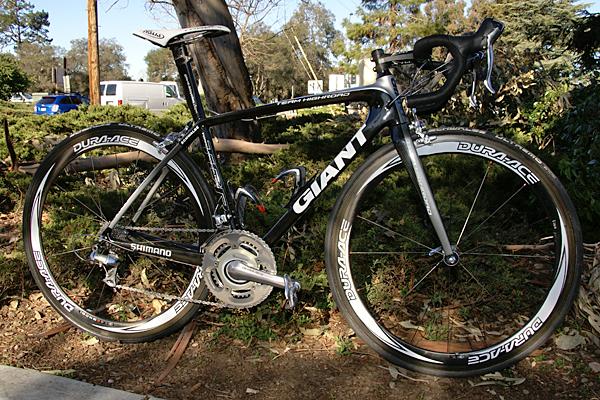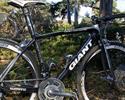
Recently on Cyclingnews.com |
Pro bikes, February 17, 2008
Mark Cavendish's Team High Road Giant TCR Advanced SL Team prototype
Out with the old in with the newBy James Huang British sprinting sensation Mark Cavendish made an impressive debut during his first season as a professional in 2007 on the German-registered T-Mobile squad. Team manager Bob Stapleton filled the roster with a wealth of young and promising talent led by an elite group of veterans and also adopted a progressive internal anti-doping program that he hoped would lead the team into a newly invigorated and clean future. Nevertheless, a high-profile flurry of long-past doping revelations led T-Mobile to remove its name as the team's title sponsor but a settlement deal has allowed Stapleton to continue on mostly as planned under the new title of Team High Road. Old team, new name...new bike!Cavendish thus heads into the 2008 season with a change of team kit and title but also a new machine as long-time sponsor Giant has outfitted the squad with a brand new version of its time-tested TCR Advanced. We tested Cavendish's actual race bike a few months back and found it to be the quintessential sprint machine with a smart drivetrain response, firm ride and edgy handling characteristics that suited its intended purpose to a T. Even so, Giant says the team's new TCR Advanced SL is a significant improvement. "We've built a bike that is lighter than what our previous TCR Advanced was, we've built a bike that's significantly stiffer than what our TCR Advanced was, [and] we've catered it specifically for the team's needs," said Giant Communications Manager Andrew Juskaitis after the official team presentation in Palo Alto, California. According to him, the bike has been in development for over two years and the team has been evaluating near-final prototypes over the last year in order to firm up any remaining details. In this final stage of testing, Team High Road will use the new TCR Advanced SL in actual race conditions, starting with the demanding Tour of California. "The bike you're looking at here is the 2009 TCR Advanced SL," continued Juskaitis. "This is not production [and] this has not come out of production molds. We still have the ability to tweak anything that the team has feedback on. Some of the angles we can change around and all that kind of stuff. Little details like cable routing and all that, we're all experimenting with what works best." The current generation TCR Advanced was already a stiff machine by most consumer standards but the team's extra-demanding requirements meant that some riders, Cavendish included, needed custom-reinforced frames that were bolstered with additional carbon fibre plies. "The bike that our team was riding last year, some of the bikes the team members had were not pure production," said Juskaitis. "They had custom lay-ups, a little bit stiffer than what the consumer could actually buy. This bike takes that even one step farther. The lay-up that the team riders are on right now is what we are prepared to sell later on in 2009." Key changes to the new TCR Advanced SL frameset include square-profile tubing in the down tube and seat tube, an oversized steerer tube that tapers from 1 1/8" up top to 1 1/4" at the crown and the use of Shimano's press-fit bottom bracket cups (first used on Scott's Addict SL last year) that affords a substantially broader down tube and more widely set chain stays. Those chain stays are also noticeably asymmetric with a taller and narrower driveside stay and a wider and rounder profile on the non-driveside. Derailleur cables were also routed internally on the team's bikes and the last section of rear brake housing actually pierced straight through the top tube as it made its way from the tube's underside near the seat tube. According to Juskaitis, "One of the key goals was two forms of stiffness: head tube stiffness for steering stability and bottom bracket stiffness, obviously, for maximum efficiency. We've gone oversize where we think it makes the most sense. We didn't go oversize where we don't think it makes the most sense. So obviously we're going to be running a larger headset, a larger bottom bracket, and press-in cups [in the bottom bracket]." In regards to the last feature, Juskaitis says that consumers will ultimately be able to run any modern external-type crankset once the TCR Advanced SL hits the market. "As a consumer, you will not be locked into a single model or brand of crankset." Stiffer yet softerFrom an earlier conversation we had with team mechanic Steve Kiusalas, team riders have indeed reported that the new bike feels "much stiffer side-to-side." In spite of the frame's increased steering precision and drivetrain rigidity, though, Juskaitis insists that ride quality has actually improved. The TCR Advanced SL retains the current version's integrated seatmast but careful shaping at the mast's base supposedly yields 'outstanding' ride comfort as compared to the current version's distinctly firm feel. "We increased stiffness significantly, but one of the things we didn't want to give up was ride quality and that's always the balance," Juskaitis said. "When you make something stiffer, a lot of times it's often going to ride like a rock. We weren't going to, nor was the team going to, accept a bike that rode like a rock. One of the secrets up our sleeves [is that] ride compliance can really be tuned quite a bit through the integrated seatmast." Team riders may now be aboard soon-to-be fully production frames for this season but Giant has still altered frame geometries to better suit their needs. Cavendish swapped from last year's standard 'medium' size to the next generation's 'team small'. According to Kiusalas, the 'team small' bears a longer top tube and shorter head tube than the standard small frame size that provides the Brit with essentially the same reach as last year but a slightly lower bar height for a more aggressive position. Seat tube angles are reportedly also a hair steeper across the board as compared to the current TCR Advanced. In keeping with current industry trends, Juskaitis says that Giant will eventually offer the new TCR Advanced SL in both geometry styles to suit a wider range of consumer needs. Other than the new frame, Cavendish's bike is largely identical to what we tested earlier this year, including the full Shimano Dura-Ace group, deep-section Dura-Ace WH-7850-C50-TU wheels, Dura-Ace SPD-SL pedals and a PRO cockpit. Cavendish has swapped from a Selle Italia Signo saddle to the company's new Thoork, though, and the team tire sponsor has shifted over to Schwalbe for the 2008 season. In contrast to what we reported earlier, Cavendish doesn't actually run the 175mm-long crankarms that came on our tester over the winter. Kiusalas surmised that that crankset was likely just what was on hand at the time to send to us as Cav's 170mm-long SRM had already been transferred to his new frameset. Either way, Cavendish sounded eager to get on with this year's Tour of California which begins on Sunday with a 3.4km (2.1mi) prologue stage around the streets of downtown Palo Alto. Be sure to check back then for live coverage as riders head out of the start house as well as continuing features and updates in the hours leading up to zero hour. PhotographyFor a thumbnail gallery of these images, click here Images by James Huang/Cyclingnews.com
| |||||
Full specificationFrame: Giant TCR Advanced SL Team prototype, size 'Team S' Critical measurements Bottom bracket: Shimano Dura-Ace press-fit |
Wheelset: Shimano Dura-Ace WH-7850-C50-TU Bars: PRO Vibe 7S Anatomic OS, 42cm (c-c) Pedals: Shimano Dura-Ace PD-7810 Total bike weight: 7.2kg (15.9lb) | ||||










